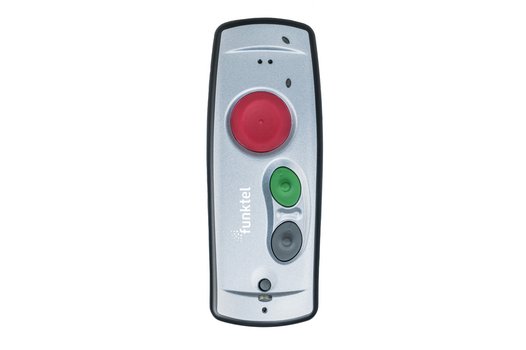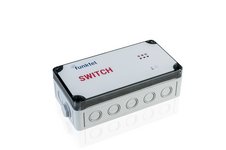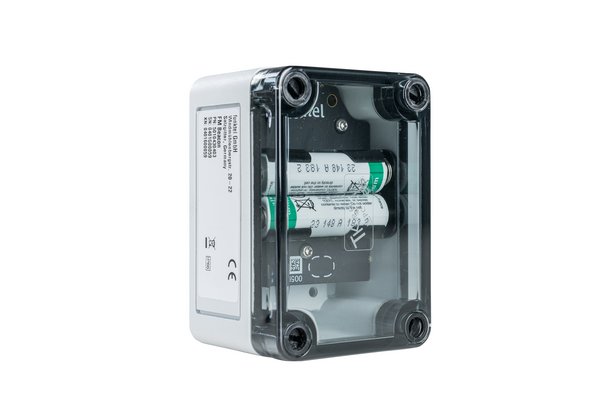Many activities are performed by persons working alone in an organisation. If an incident/accident should occur, first responders must be able to locate the lone worker quickly in order to render assistance. The funktel FM GSM personal emergency signal system ensures that situations that are hazardous for lone workers are detected and that alarm information, including the location of the incident/accident, is forwarded to the rescue services.
The small, robust and easy-to-operate funktel FM6 GSM personal emergency signal system detects potentially hazardous situations automatically and also enables the lone worker to summon help deliberately by operating the alarm button by touch alone.
An aural pre-alarm is triggered when a hazardous situation is detected. The lone worker can cancel the alarm if he/she does not require assistance. If the lone worker does not cancel the pre-alarm or if he/she has summoned help deliberately, then the funktel FM6 GSM personal emergency signal device forwards the cause of the incident/accident (fall, position, no-movement, time, flight) and the location of the incident/accident, which it has determined by means of GPS/A-GPS outdoors and with the aid of funktel beacons inside buildings. The funktel GSM personal emergency signal device uses the mobile phone network as well as a second, integrated ISM band radio module to forward this information.
Forwarding of the alarms can be configured in various ways. This enables a data SMS to be forwarded to an alarm control centre, where the alarm including a graphic display of the location can be reported and processed in the event of an incident/accident. The device that is involved in the incident/accident can also be contacted from here, enabling it to be switched to hands-free and speaker mode by remote control so that the casualty can describe the emergency situation without having to operate the device. Alternatively, an alarm SMS can also be sent directly to colleagues and first responders who are in the vicinity of the incident/accident to provide prompt assistance.
Once they have reached the location of the incident/accident, first responders must locate the lone worker as quickly as possible - and this is where the “short-range acoustic localisation” feature comes into play. The funktel FM6 generates a loud acoustic signal that also enables a lone worker to be found in cluttered spaces, even if he/she cannot call for assistance.
Ease of operation is of paramount importance in the case of the FM6. All functions, including the compulsory sensor test when switching on, are supported by voice prompts (configurable in multiple languages) and the large buttons enable operation by touch alone. This even enables persons who work alone infrequently to use the device safely after brief training.
Features
- Personal emergency signal system certified by the German Employers’ Liability Insurance Association; complies with DIN VDE V0825-11, DGUV 212-139 for hazardous solitary workplaces
- Complete system including GSM personal emergency signal devices, an alarm control centre, localisation beacons and repeater technology
- Personal emergency signal control centre with a graphic display showing the location of the alarm; GSM voice connection set up automatically with subscriber who has triggered the alarm; acknowledgement and reset function
- Personal safety and voice communication in a single device
- Transmission via 4G/LTE
- Alarm notification in the absence of a GSM connection by means of an additionally integrated ISM band radio network
- Voice-activated user prompting (multi-lingual) for logon and sensor test
- Integrated personal emergency signal functions
- Pushbutton alarm (will-dependent/manual)
- Position, no-movement, flight and time alarm (will-independent/automatic)
- Localisation function by means of ISM band FM localisation beacons. GPS/A-GPS satellite outdoor localisation, loud acoustic localisation (loudspeaker)
- Alarm can also be relayed via ISM band by means of a funktel Repeater, Wallbox, Gateway or Switch in the absence of a GSM network
- Cyclic life-check self-monitoring with automatic transmission of technical alarms
- System parameterisation by remote maintenance
- Integration of interfaces for switch contacts, technical alarms and many others possible
- Optional guard control function
Alarm triggering modes
Alarm pushbutton, manual
Typical workwear in hazardous environments comprises protective masks and gloves, which are not permitted to pose a handicap when triggering an alarm. The red button can also be felt sight unseen and triggered unmistakeably in conditions of extreme emergency... even when the device is switched off.
Position alarm
Triggering in the event of a horizontal position being maintained for a specific, configurable time. If the angle of inclination is exceeded and the pre-alarm time (voice prompt) has elapsed, an alarm is triggered automatically.
Time alarm
Triggered if a key is not pressed within a specified, configurable period of time. In order to detect if a lone worker is present and awake, he/she must press a button periodically.
No-motion alarm
The no-motion alarm is triggered if a person does not move or remains inactive for a specific (configurable) period of time. This may be the case after a fall or when unconscious.
Flight alarm
A flight alarm is triggered automatically when the device is moved for an extended period of time (configurable); it is triggered when there is a threat or an emergency that forces the person to flee, such as a fire or explosion.
Fall alarm
Automatic triggering of an alarm, with configurable sensitivity, in the event of a fall.








